聚合物和添加剂
塑料的主要化学成分
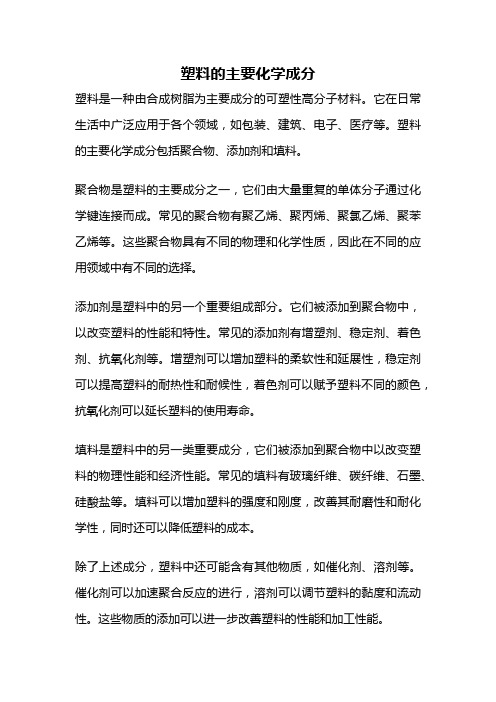
塑料的主要化学成分
塑料是一种由合成树脂为主要成分的可塑性高分子材料。
它在日常生活中广泛应用于各个领域,如包装、建筑、电子、医疗等。
塑料的主要化学成分包括聚合物、添加剂和填料。
聚合物是塑料的主要成分之一,它们由大量重复的单体分子通过化学键连接而成。
常见的聚合物有聚乙烯、聚丙烯、聚氯乙烯、聚苯乙烯等。
这些聚合物具有不同的物理和化学性质,因此在不同的应用领域中有不同的选择。
添加剂是塑料中的另一个重要组成部分。
它们被添加到聚合物中,以改变塑料的性能和特性。
常见的添加剂有增塑剂、稳定剂、着色剂、抗氧化剂等。
增塑剂可以增加塑料的柔软性和延展性,稳定剂可以提高塑料的耐热性和耐候性,着色剂可以赋予塑料不同的颜色,抗氧化剂可以延长塑料的使用寿命。
填料是塑料中的另一类重要成分,它们被添加到聚合物中以改变塑料的物理性能和经济性能。
常见的填料有玻璃纤维、碳纤维、石墨、硅酸盐等。
填料可以增加塑料的强度和刚度,改善其耐磨性和耐化学性,同时还可以降低塑料的成本。
除了上述成分,塑料中还可能含有其他物质,如催化剂、溶剂等。
催化剂可以加速聚合反应的进行,溶剂可以调节塑料的黏度和流动性。
这些物质的添加可以进一步改善塑料的性能和加工性能。
总结起来,塑料的主要化学成分包括聚合物、添加剂和填料。
聚合物是塑料的基础,添加剂可以改变塑料的性能和特性,填料可以改变塑料的物理性能和经济性能。
这些成分的选择和配比将直接影响塑料的性能和应用领域。
随着科技的发展,人们对塑料的研究和开发将会越来越深入,相信未来塑料将会在更多的领域发挥重要作用。
混凝土中的聚合物添加剂技术规程
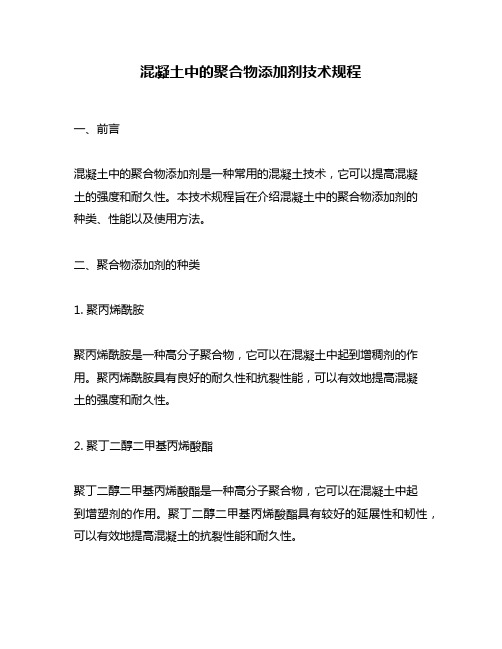
混凝土中的聚合物添加剂技术规程一、前言混凝土中的聚合物添加剂是一种常用的混凝土技术,它可以提高混凝土的强度和耐久性。
本技术规程旨在介绍混凝土中的聚合物添加剂的种类、性能以及使用方法。
二、聚合物添加剂的种类1. 聚丙烯酰胺聚丙烯酰胺是一种高分子聚合物,它可以在混凝土中起到增稠剂的作用。
聚丙烯酰胺具有良好的耐久性和抗裂性能,可以有效地提高混凝土的强度和耐久性。
2. 聚丁二醇二甲基丙烯酸酯聚丁二醇二甲基丙烯酸酯是一种高分子聚合物,它可以在混凝土中起到增塑剂的作用。
聚丁二醇二甲基丙烯酸酯具有较好的延展性和韧性,可以有效地提高混凝土的抗裂性能和耐久性。
3. 聚合物改性剂聚合物改性剂是一种可以改善混凝土性能的添加剂,它可以增加混凝土的强度和耐久性。
聚合物改性剂可以分为两种类型:一种是水溶性的聚合物改性剂,它可以在混凝土中起到增塑剂的作用;另一种是油溶性的聚合物改性剂,它可以在混凝土中起到减水剂的作用。
三、聚合物添加剂的性能1. 增强混凝土的强度和硬度聚合物添加剂可以在混凝土中形成一种网络结构,从而提高混凝土的强度和硬度。
聚合物添加剂可以填充混凝土中的空隙,从而增加混凝土的密度和强度。
2. 提高混凝土的抗裂性能聚合物添加剂可以使混凝土的内部结构更加均匀,从而提高混凝土的抗裂性能。
聚合物添加剂可以防止混凝土中的微裂纹扩展,从而增强混凝土的耐久性。
3. 提高混凝土的耐久性聚合物添加剂可以使混凝土的表面更加光滑,从而减少水分和氧气的渗透。
聚合物添加剂可以防止混凝土中的钢筋生锈,从而延长混凝土的使用寿命。
四、聚合物添加剂的使用方法1. 混凝土配合比的确定在使用聚合物添加剂之前,首先需要确定混凝土的配合比。
混凝土的配合比应根据混凝土的使用要求和实际情况来确定,同时还要考虑到聚合物添加剂的使用量和性能。
2. 聚合物添加剂的投放在混凝土搅拌过程中,应在适当的时间将聚合物添加剂均匀地投放到混凝土中。
为了达到最佳的混合效果,聚合物添加剂应该在混凝土搅拌的早期阶段投放。
胶水与金属粘结的原理
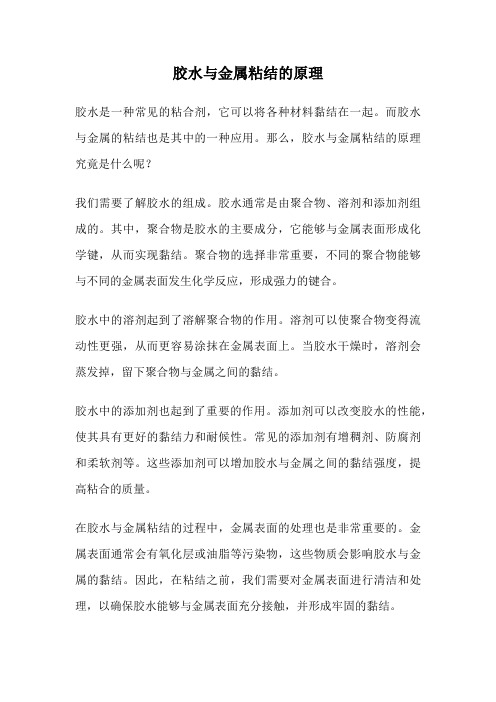
胶水与金属粘结的原理胶水是一种常见的粘合剂,它可以将各种材料黏结在一起。
而胶水与金属的粘结也是其中的一种应用。
那么,胶水与金属粘结的原理究竟是什么呢?我们需要了解胶水的组成。
胶水通常是由聚合物、溶剂和添加剂组成的。
其中,聚合物是胶水的主要成分,它能够与金属表面形成化学键,从而实现黏结。
聚合物的选择非常重要,不同的聚合物能够与不同的金属表面发生化学反应,形成强力的键合。
胶水中的溶剂起到了溶解聚合物的作用。
溶剂可以使聚合物变得流动性更强,从而更容易涂抹在金属表面上。
当胶水干燥时,溶剂会蒸发掉,留下聚合物与金属之间的黏结。
胶水中的添加剂也起到了重要的作用。
添加剂可以改变胶水的性能,使其具有更好的黏结力和耐候性。
常见的添加剂有增稠剂、防腐剂和柔软剂等。
这些添加剂可以增加胶水与金属之间的黏结强度,提高粘合的质量。
在胶水与金属粘结的过程中,金属表面的处理也是非常重要的。
金属表面通常会有氧化层或油脂等污染物,这些物质会影响胶水与金属的黏结。
因此,在粘结之前,我们需要对金属表面进行清洁和处理,以确保胶水能够与金属表面充分接触,并形成牢固的黏结。
总结起来,胶水与金属粘结的原理是通过胶水中的聚合物与金属表面形成化学键,从而实现黏结。
胶水中的溶剂和添加剂能够改善胶水的性能,使其具有更好的黏结力和耐候性。
同时,金属表面的处理也是确保黏结质量的重要环节。
胶水与金属的粘结不仅可以用于家居装修和手工制作,还在工业生产中得到广泛应用。
通过合理选择胶水和适当处理金属表面,我们能够实现金属与金属之间的粘结,为各种应用提供了便利。
光刻胶的化学成分
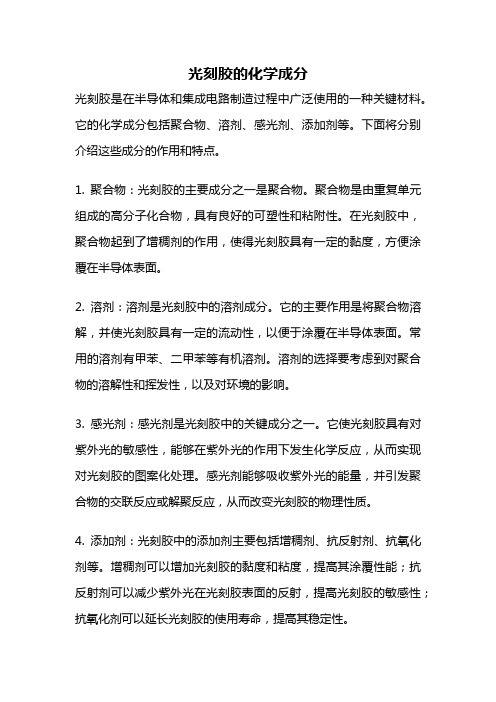
光刻胶的化学成分光刻胶是在半导体和集成电路制造过程中广泛使用的一种关键材料。
它的化学成分包括聚合物、溶剂、感光剂、添加剂等。
下面将分别介绍这些成分的作用和特点。
1. 聚合物:光刻胶的主要成分之一是聚合物。
聚合物是由重复单元组成的高分子化合物,具有良好的可塑性和粘附性。
在光刻胶中,聚合物起到了增稠剂的作用,使得光刻胶具有一定的黏度,方便涂覆在半导体表面。
2. 溶剂:溶剂是光刻胶中的溶剂成分。
它的主要作用是将聚合物溶解,并使光刻胶具有一定的流动性,以便于涂覆在半导体表面。
常用的溶剂有甲苯、二甲苯等有机溶剂。
溶剂的选择要考虑到对聚合物的溶解性和挥发性,以及对环境的影响。
3. 感光剂:感光剂是光刻胶中的关键成分之一。
它使光刻胶具有对紫外光的敏感性,能够在紫外光的作用下发生化学反应,从而实现对光刻胶的图案化处理。
感光剂能够吸收紫外光的能量,并引发聚合物的交联反应或解聚反应,从而改变光刻胶的物理性质。
4. 添加剂:光刻胶中的添加剂主要包括增稠剂、抗反射剂、抗氧化剂等。
增稠剂可以增加光刻胶的黏度和粘度,提高其涂覆性能;抗反射剂可以减少紫外光在光刻胶表面的反射,提高光刻胶的敏感性;抗氧化剂可以延长光刻胶的使用寿命,提高其稳定性。
光刻胶的化学成分在半导体和集成电路制造中起着重要的作用。
聚合物提供了光刻胶的基础性能,使得光刻胶具有一定的黏度和粘附性;溶剂使得光刻胶具有流动性,方便涂覆和加工;感光剂使得光刻胶对紫外光具有敏感性,实现对光刻胶的图案化处理;添加剂则能够改善光刻胶的性能和稳定性。
光刻胶的化学成分是多种多样的,每种成分都有其独特的作用和特点。
这些成分相互作用,共同发挥作用,使得光刻胶在半导体和集成电路制造中具有重要的应用价值。
随着技术的不断发展,光刻胶的化学成分也在不断创新和改进,以满足对高性能、高精度制造的需求。
聚合物防水砂浆配方

聚合物防水砂浆配方聚合物防水砂浆是一种常用于建筑工程中的防水材料,它具有出色的防水性能和可靠的耐久性。
本文将以从简到繁的方式,探讨聚合物防水砂浆的配方,帮助您更深入地了解这个主题。
一、聚合物防水砂浆的基本成分聚合物防水砂浆的基本成分包括水泥、砂子、聚合物添加剂和其他辅助成分。
下面是常见的聚合物防水砂浆配方的基本比例:1. 水泥:砂子 = 1:32. 聚合物添加剂:水泥 = 5%:100%在配制聚合物防水砂浆时,首先要将适量的水泥加入到砂子中,并混合均匀。
将聚合物添加剂逐渐加入混合物中,并搅拌至粘稠的状况。
根据需要适量加水,调整砂浆的流动性和可施工性。
二、聚合物防水砂浆的功能1. 防水功能:聚合物添加剂能够改善砂浆的防水性能,提高其抗渗透性和抗水压能力,有效防止水分渗透到建筑物内部。
2. 增强功能:聚合物添加剂可以提高砂浆的强度和耐久性,增加其抗裂性和抗震性能,从而提高建筑物的整体结构稳定性。
3. 粘结功能:聚合物添加剂可以增强砂浆与基层材料的粘结强度,减少剥离现象的发生,确保建筑物的结构牢固可靠。
三、聚合物防水砂浆配方的优化为了进一步提升聚合物防水砂浆的性能,可以根据具体需求对配方进行优化。
以下是一些常用的优化方法:1. 添加细颗粒填料:适量添加细颗粒填料,如硅灰或微粉,可以增加砂浆的紧密性和致密性,提高其抗压强度和耐久性。
2. 控制水灰比:适当控制水灰比可以提高砂浆的流动性和可施工性,但过高的水灰比会降低其强度和耐久性。
在调整配方时应注意平衡水灰比的关系。
3. 添加添加剂:根据需要,可以选择不同种类的聚合物添加剂,如增粘剂、加固剂、稳定剂等,以进一步改善砂浆的性能。
四、聚合物防水砂浆的应用范围聚合物防水砂浆广泛应用于各类建筑工程中,特别适用于以下情况:1. 地下室防水:由于地下室易受水分渗透和露水侵袭,聚合物防水砂浆可以有效提高地下室的防水性能,防止水腐蚀和漏水问题的发生。
2. 浴室防水:浴室是一个湿度较高的区域,使用聚合物防水砂浆可以有效防止墙面和地面的渗水问题,保护建筑物的结构安全。
工程塑料的成分
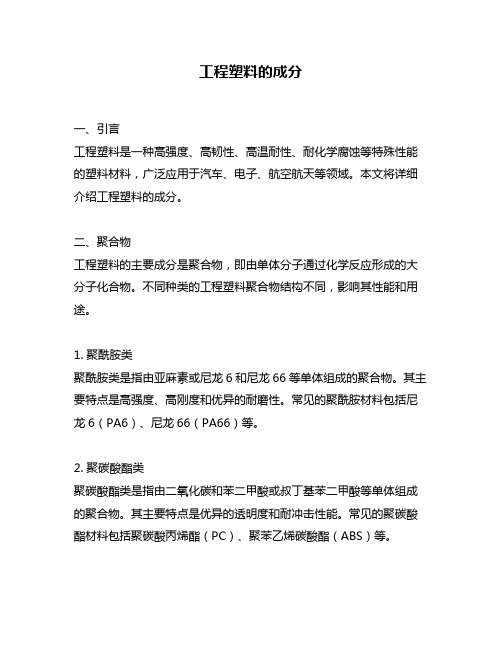
工程塑料的成分一、引言工程塑料是一种高强度、高韧性、高温耐性、耐化学腐蚀等特殊性能的塑料材料,广泛应用于汽车、电子、航空航天等领域。
本文将详细介绍工程塑料的成分。
二、聚合物工程塑料的主要成分是聚合物,即由单体分子通过化学反应形成的大分子化合物。
不同种类的工程塑料聚合物结构不同,影响其性能和用途。
1. 聚酰胺类聚酰胺类是指由亚麻素或尼龙6和尼龙66等单体组成的聚合物。
其主要特点是高强度、高刚度和优异的耐磨性。
常见的聚酰胺材料包括尼龙6(PA6)、尼龙66(PA66)等。
2. 聚碳酸酯类聚碳酸酯类是指由二氧化碳和苯二甲酸或叔丁基苯二甲酸等单体组成的聚合物。
其主要特点是优异的透明度和耐冲击性能。
常见的聚碳酸酯材料包括聚碳酸丙烯酯(PC)、聚苯乙烯碳酸酯(ABS)等。
3. 聚醚类聚醚类是指由环氧化合物和胺等单体组成的聚合物。
其主要特点是优异的耐热性和耐化学腐蚀性能。
常见的聚醚材料包括环氧树脂(EP)、聚对苯二甲酰氧基乙基苯乙烯(PPO)等。
4. 聚丙烯类聚丙烯类是指由丙烯单体组成的聚合物。
其主要特点是低密度、高刚度和优异的耐化学腐蚀性能。
常见的聚丙烯材料包括聚丙烯(PP)、高密度聚乙烯(HDPE)等。
5. 聚氨酯类聚氨酯类是指由异氰酸酯和多元醇等单体组成的聚合物。
其主要特点是优异的弹性和耐冲击性能。
常见的聚氨酯材料包括硬质泡沫板、软质泡沫板等。
三、填料填料是指添加到聚合物中的材料,用于改善工程塑料的力学性能、热稳定性和耐用性等。
不同种类的填料对工程塑料的性能影响不同。
1. 玻璃纤维玻璃纤维是一种常用的填料,可以显著提高工程塑料的强度和刚度。
常见的玻璃纤维增强材料包括玻璃纤维增强尼龙(GFPA)、玻璃纤维增强聚酰胺(GFPA)等。
2. 碳纤维碳纤维是一种高强度、低密度的填料,可以显著提高工程塑料的强度和刚度。
常见的碳纤维增强材料包括碳纤维增强聚酰胺(CFPA)、碳纤维增强聚醚酯(CPE)等。
3. 石墨石墨是一种具有优异导电性和耐高温性能的填料,可以用于制备导电工程塑料。
各种塑料添加剂简介
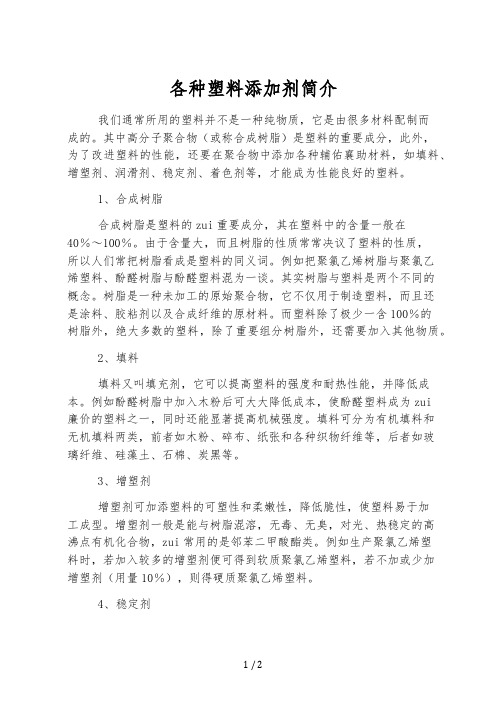
各种塑料添加剂简介我们通常所用的塑料并不是一种纯物质,它是由很多材料配制而成的。
其中高分子聚合物(或称合成树脂)是塑料的重要成分,此外,为了改进塑料的性能,还要在聚合物中添加各种辅佑襄助材料,如填料、增塑剂、润滑剂、稳定剂、着色剂等,才能成为性能良好的塑料。
1、合成树脂合成树脂是塑料的zui重要成分,其在塑料中的含量一般在40%~100%。
由于含量大,而且树脂的性质常常决议了塑料的性质,所以人们常把树脂看成是塑料的同义词。
例如把聚氯乙烯树脂与聚氯乙烯塑料、酚醛树脂与酚醛塑料混为一谈。
其实树脂与塑料是两个不同的概念。
树脂是一种未加工的原始聚合物,它不仅用于制造塑料,而且还是涂料、胶粘剂以及合成纤维的原材料。
而塑料除了极少一含100%的树脂外,绝大多数的塑料,除了重要组分树脂外,还需要加入其他物质。
2、填料填料又叫填充剂,它可以提高塑料的强度和耐热性能,并降低成本。
例如酚醛树脂中加入木粉后可大大降低成本,使酚醛塑料成为zui廉价的塑料之一,同时还能显著提高机械强度。
填料可分为有机填料和无机填料两类,前者如木粉、碎布、纸张和各种织物纤维等,后者如玻璃纤维、硅藻土、石棉、炭黑等。
3、增塑剂增塑剂可加添塑料的可塑性和柔嫩性,降低脆性,使塑料易于加工成型。
增塑剂一般是能与树脂混溶,无毒、无臭,对光、热稳定的高沸点有机化合物,zui常用的是邻苯二甲酸酯类。
例如生产聚氯乙烯塑料时,若加入较多的增塑剂便可得到软质聚氯乙烯塑料,若不加或少加增塑剂(用量10%),则得硬质聚氯乙烯塑料。
4、稳定剂为了防止合成树脂在加工和使用过程中受光和热的作用分解和破坏,延长使用寿命,要在塑料中加入稳定剂。
常用的有硬脂酸盐、环氧树脂等。
5、着色剂着色剂可使塑料具有各种明丽、美观的颜色。
常用有机染料和无机颜料作为着色剂。
6、润滑剂润滑剂的作用是防止塑料在成型时不粘在金属模具上,同时可使塑料的表面光滑美观。
常用的润滑剂有硬脂酸及其钙镁盐等。
微塑料的成分组成
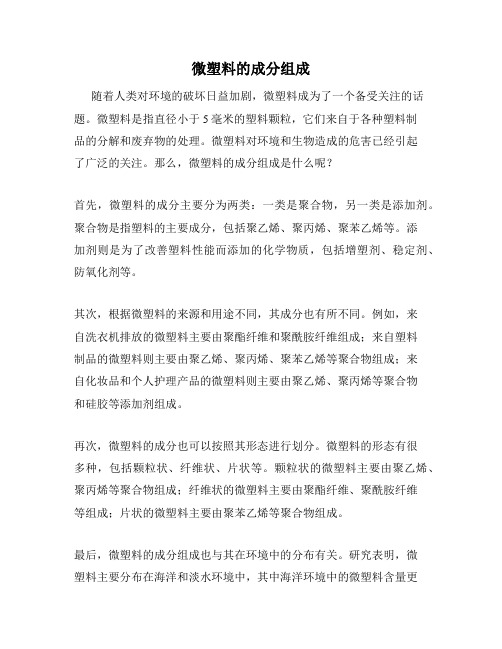
微塑料的成分组成随着人类对环境的破坏日益加剧,微塑料成为了一个备受关注的话题。
微塑料是指直径小于5毫米的塑料颗粒,它们来自于各种塑料制品的分解和废弃物的处理。
微塑料对环境和生物造成的危害已经引起了广泛的关注。
那么,微塑料的成分组成是什么呢?首先,微塑料的成分主要分为两类:一类是聚合物,另一类是添加剂。
聚合物是指塑料的主要成分,包括聚乙烯、聚丙烯、聚苯乙烯等。
添加剂则是为了改善塑料性能而添加的化学物质,包括增塑剂、稳定剂、防氧化剂等。
其次,根据微塑料的来源和用途不同,其成分也有所不同。
例如,来自洗衣机排放的微塑料主要由聚酯纤维和聚酰胺纤维组成;来自塑料制品的微塑料则主要由聚乙烯、聚丙烯、聚苯乙烯等聚合物组成;来自化妆品和个人护理产品的微塑料则主要由聚乙烯、聚丙烯等聚合物和硅胶等添加剂组成。
再次,微塑料的成分也可以按照其形态进行划分。
微塑料的形态有很多种,包括颗粒状、纤维状、片状等。
颗粒状的微塑料主要由聚乙烯、聚丙烯等聚合物组成;纤维状的微塑料主要由聚酯纤维、聚酰胺纤维等组成;片状的微塑料主要由聚苯乙烯等聚合物组成。
最后,微塑料的成分组成也与其在环境中的分布有关。
研究表明,微塑料主要分布在海洋和淡水环境中,其中海洋环境中的微塑料含量更高。
海洋中的微塑料主要由聚乙烯、聚丙烯等聚合物组成,而淡水环境中的微塑料则主要由聚酯纤维、聚酰胺纤维等组成。
综上所述,微塑料的成分组成是多种多样的,包括聚合物和添加剂两类,来源和用途不同的微塑料成分也有所不同。
了解微塑料的成分组成,有助于我们更好地认识微塑料的危害和防治措施。
我们应该采取有效的措施,减少塑料制品的使用和废弃物的排放,保护我们的环境和生态系统。
混凝土中聚合物添加剂使用方法
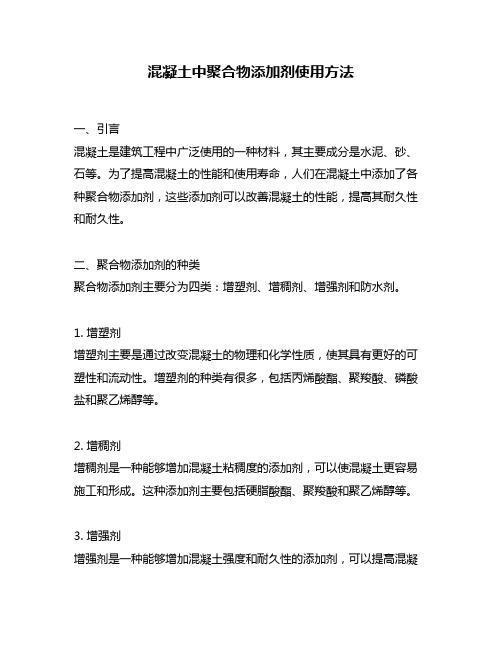
混凝土中聚合物添加剂使用方法一、引言混凝土是建筑工程中广泛使用的一种材料,其主要成分是水泥、砂、石等。
为了提高混凝土的性能和使用寿命,人们在混凝土中添加了各种聚合物添加剂,这些添加剂可以改善混凝土的性能,提高其耐久性和耐久性。
二、聚合物添加剂的种类聚合物添加剂主要分为四类:增塑剂、增稠剂、增强剂和防水剂。
1. 增塑剂增塑剂主要是通过改变混凝土的物理和化学性质,使其具有更好的可塑性和流动性。
增塑剂的种类有很多,包括丙烯酸酯、聚羧酸、磷酸盐和聚乙烯醇等。
2. 增稠剂增稠剂是一种能够增加混凝土粘稠度的添加剂,可以使混凝土更容易施工和形成。
这种添加剂主要包括硬脂酸酯、聚羧酸和聚乙烯醇等。
3. 增强剂增强剂是一种能够增加混凝土强度和耐久性的添加剂,可以提高混凝土的抗压强度、抗拉强度和耐久性。
增强剂的种类包括纤维素、玻璃纤维、碳纤维等。
4. 防水剂防水剂是一种能够使混凝土具有防水性能的添加剂,可以提高混凝土的耐水性和耐候性。
防水剂的种类包括聚氨酯、环氧树脂和聚酯等。
三、聚合物添加剂的使用方法在混凝土中添加聚合物添加剂时,需要根据具体情况选择适当的添加量和添加时间。
以下是聚合物添加剂的使用方法:1. 增塑剂的使用方法(1)选择适当的增塑剂种类和添加量;(2)将增塑剂加入混凝土中,并充分搅拌均匀;(3)根据混凝土的性质和环境条件,调整增塑剂的添加量。
2. 增稠剂的使用方法(1)选择适当的增稠剂种类和添加量;(2)将增稠剂加入混凝土中,并充分搅拌均匀;(3)根据混凝土的性质和环境条件,调整增稠剂的添加量。
3. 增强剂的使用方法(1)选择适当的增强剂种类和添加量;(2)将增强剂加入混凝土中,并充分搅拌均匀;(3)根据混凝土的性质和环境条件,调整增强剂的添加量。
4. 防水剂的使用方法(1)选择适当的防水剂种类和添加量;(2)将防水剂加入混凝土中,并充分搅拌均匀;(3)根据混凝土的性质和环境条件,调整防水剂的添加量。
四、聚合物添加剂的注意事项在使用聚合物添加剂时,需要注意以下事项:1. 选择适当的聚合物添加剂种类和添加量,不要过量添加;2. 在添加聚合物添加剂前,应该对添加剂进行试验验证;3. 混凝土中添加聚合物添加剂后,应该及时进行混凝土的抗压强度和耐久性等性能测试;4. 聚合物添加剂的存放应该避免阳光直射和高温环境。
尼龙成分表
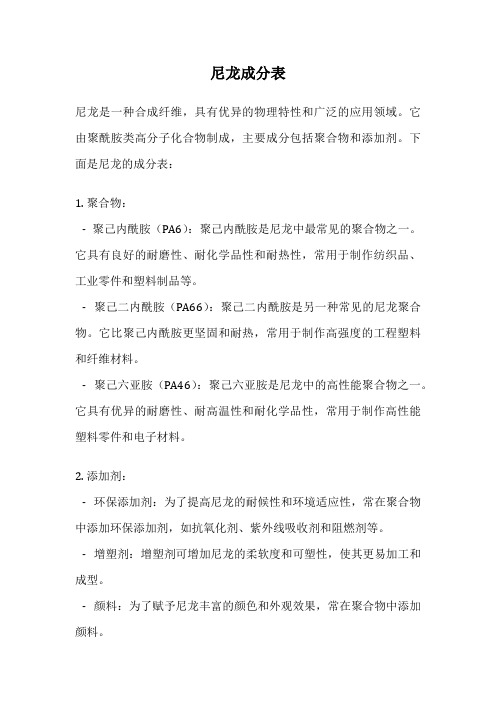
尼龙成分表尼龙是一种合成纤维,具有优异的物理特性和广泛的应用领域。
它由聚酰胺类高分子化合物制成,主要成分包括聚合物和添加剂。
下面是尼龙的成分表:1. 聚合物:- 聚己内酰胺(PA6):聚己内酰胺是尼龙中最常见的聚合物之一。
它具有良好的耐磨性、耐化学品性和耐热性,常用于制作纺织品、工业零件和塑料制品等。
- 聚己二内酰胺(PA66):聚己二内酰胺是另一种常见的尼龙聚合物。
它比聚己内酰胺更坚固和耐热,常用于制作高强度的工程塑料和纤维材料。
- 聚己六亚胺(PA46):聚己六亚胺是尼龙中的高性能聚合物之一。
它具有优异的耐磨性、耐高温性和耐化学品性,常用于制作高性能塑料零件和电子材料。
2. 添加剂:- 环保添加剂:为了提高尼龙的耐候性和环境适应性,常在聚合物中添加环保添加剂,如抗氧化剂、紫外线吸收剂和阻燃剂等。
- 增塑剂:增塑剂可增加尼龙的柔软度和可塑性,使其更易加工和成型。
- 颜料:为了赋予尼龙丰富的颜色和外观效果,常在聚合物中添加颜料。
尼龙的成分表反映了其复杂的化学结构和多样的性能特点。
这些成分使得尼龙成为一种重要的工程材料,广泛应用于纺织、汽车、电子、航空航天等领域。
它在现代生活中扮演着重要的角色,为人们提供了更多便利和舒适。
无论是在衣物、家居用品还是工业设备中,尼龙都发挥着不可或缺的作用。
尼龙成分表的描述力求准确无误,以便读者对尼龙的成分和特性有更清晰的了解。
通过对尼龙成分的详细介绍,读者可以更好地理解尼龙的优点和应用领域,从而更好地利用尼龙的特性满足自身需求。
尼龙的成分表为读者提供了一份有价值的参考,帮助他们更好地了解和应用尼龙材料。
聚合物材料的改性与应用
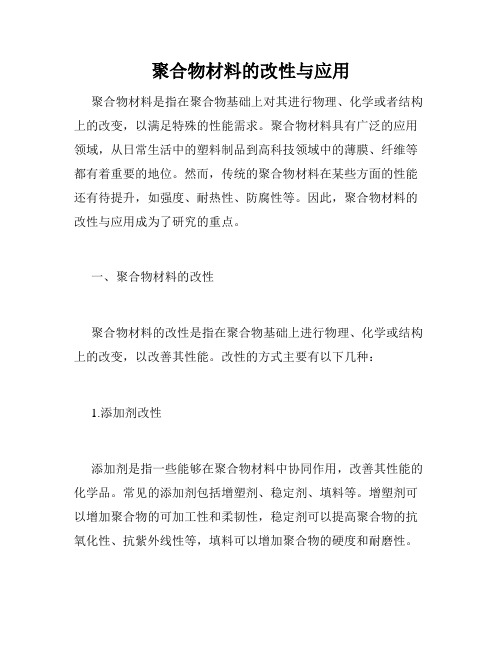
聚合物材料的改性与应用聚合物材料是指在聚合物基础上对其进行物理、化学或者结构上的改变,以满足特殊的性能需求。
聚合物材料具有广泛的应用领域,从日常生活中的塑料制品到高科技领域中的薄膜、纤维等都有着重要的地位。
然而,传统的聚合物材料在某些方面的性能还有待提升,如强度、耐热性、防腐性等。
因此,聚合物材料的改性与应用成为了研究的重点。
一、聚合物材料的改性聚合物材料的改性是指在聚合物基础上进行物理、化学或结构上的改变,以改善其性能。
改性的方式主要有以下几种:1.添加剂改性添加剂是指一些能够在聚合物材料中协同作用,改善其性能的化学品。
常见的添加剂包括增塑剂、稳定剂、填料等。
增塑剂可以增加聚合物的可加工性和柔韧性,稳定剂可以提高聚合物的抗氧化性、抗紫外线性等,填料可以增加聚合物的硬度和耐磨性。
2.共聚改性共聚改性是指将两种或更多的单体聚合在一起,形成聚合物混合物。
由于其中不同单体聚合时的结构不同,所以可以通过共聚来得到更好的性能。
例如,将苯乙烯与丁苯橡胶共聚,可以得到一个既有坚硬度又有韧性的ABS材料。
3.交联改性交联改性是指通过一定的化学反应,在聚合物材料中形成交联结构,使其硬度、强度、耐热性等性能得到提升。
通常采用的交联剂有过氧化物、硫化剂等。
交联改性的聚合物又称为热塑性弹性体(TPE)。
二、聚合物材料的应用聚合物材料具有轻质、耐腐蚀、高强度、绝缘性好等优点,因此在众多领域中有广泛的应用。
1.包装领域聚合物材料在包装领域中应用广泛,如塑料袋、瓶子、盒子等。
经过改性后,聚合物材料的各项性能得到提升,可以更好地保护物品,并增加包装的美观性。
2.建筑领域聚合物材料在建筑领域中应用广泛,如隔热材料、防水材料、地板材料等。
通过改性,聚合物材料可以满足建筑材料的强度、耐腐蚀性等要求,同时还具有重量轻、易加工等优点。
3.汽车领域汽车零部件中常常采用聚合物材料,如车身外壳、车门、座椅等。
聚合物材料的轻量化、材质坚韧可塑性好等特点,可以满足汽车制造中的要求。
塑料的基本概念
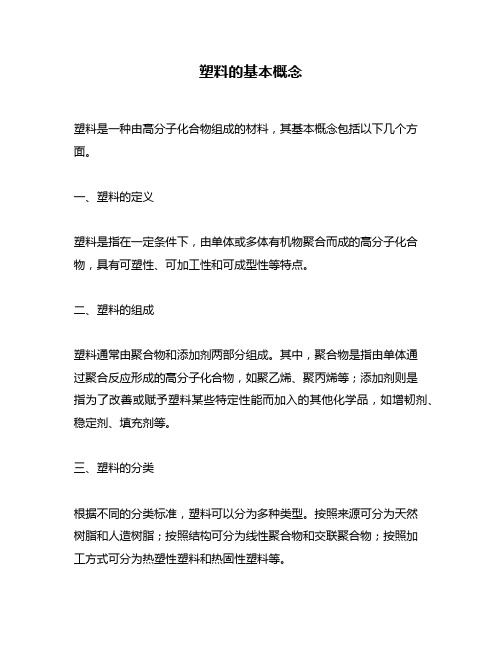
塑料的基本概念塑料是一种由高分子化合物组成的材料,其基本概念包括以下几个方面。
一、塑料的定义塑料是指在一定条件下,由单体或多体有机物聚合而成的高分子化合物,具有可塑性、可加工性和可成型性等特点。
二、塑料的组成塑料通常由聚合物和添加剂两部分组成。
其中,聚合物是指由单体通过聚合反应形成的高分子化合物,如聚乙烯、聚丙烯等;添加剂则是指为了改善或赋予塑料某些特定性能而加入的其他化学品,如增韧剂、稳定剂、填充剂等。
三、塑料的分类根据不同的分类标准,塑料可以分为多种类型。
按照来源可分为天然树脂和人造树脂;按照结构可分为线性聚合物和交联聚合物;按照加工方式可分为热塑性塑料和热固性塑料等。
四、塑料的特点1. 可塑性:即能够在一定温度范围内变形,并保持所形成形状不变。
2. 可加工性:即能够通过加热、压力等方式进行成型、切割、焊接等操作。
3. 可成型性:即能够通过模具或挤出机等设备将塑料制成所需形状。
4. 轻质:相对于金属材料而言,塑料具有较轻的重量,便于搬运和使用。
5. 耐腐蚀性:塑料通常具有较好的耐酸碱、耐氧化和耐腐蚀性能。
五、塑料的应用随着科技的进步和工业的发展,塑料已经广泛应用于各个领域。
例如,在包装行业中,塑料袋、保鲜膜等产品已经取代了传统的纸张和布料;在建筑行业中,PVC管道、隔热材料等产品也得到了广泛应用;在汽车制造行业中,ABS材料、聚碳酸酯等高强度塑料也得到了广泛应用。
综上所述,塑料是一种重要的高分子化合物,在现代工业生产和日常生活中扮演着重要角色。
它具有可塑性、可加工性和可成型性等特点,并且应用范围广泛,为人们的生产和生活带来了很多便利。
钟化ms聚合物成分
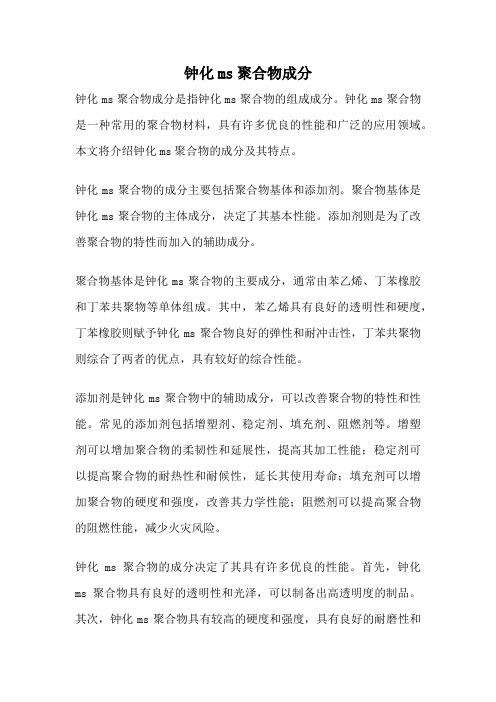
钟化ms聚合物成分钟化ms聚合物成分是指钟化ms聚合物的组成成分。
钟化ms聚合物是一种常用的聚合物材料,具有许多优良的性能和广泛的应用领域。
本文将介绍钟化ms聚合物的成分及其特点。
钟化ms聚合物的成分主要包括聚合物基体和添加剂。
聚合物基体是钟化ms聚合物的主体成分,决定了其基本性能。
添加剂则是为了改善聚合物的特性而加入的辅助成分。
聚合物基体是钟化ms聚合物的主要成分,通常由苯乙烯、丁苯橡胶和丁苯共聚物等单体组成。
其中,苯乙烯具有良好的透明性和硬度,丁苯橡胶则赋予钟化ms聚合物良好的弹性和耐冲击性,丁苯共聚物则综合了两者的优点,具有较好的综合性能。
添加剂是钟化ms聚合物中的辅助成分,可以改善聚合物的特性和性能。
常见的添加剂包括增塑剂、稳定剂、填充剂、阻燃剂等。
增塑剂可以增加聚合物的柔韧性和延展性,提高其加工性能;稳定剂可以提高聚合物的耐热性和耐候性,延长其使用寿命;填充剂可以增加聚合物的硬度和强度,改善其力学性能;阻燃剂可以提高聚合物的阻燃性能,减少火灾风险。
钟化ms聚合物的成分决定了其具有许多优良的性能。
首先,钟化ms聚合物具有良好的透明性和光泽,可以制备出高透明度的制品。
其次,钟化ms聚合物具有较高的硬度和强度,具有良好的耐磨性和耐冲击性,适用于制作各种机械零件和外壳。
此外,钟化ms聚合物还具有较好的耐化学性和电绝缘性,适用于制作化学容器和电子元件。
钟化ms聚合物的成分也决定了其在许多领域具有广泛的应用。
首先,在家居用品领域,钟化ms聚合物可以制作高透明度的玻璃制品、餐具和家居装饰品。
其次,在电子领域,钟化ms聚合物可以制作电子元件的外壳和隔离材料。
此外,在汽车工业领域,钟化ms聚合物可以用于制作汽车零部件和内饰件。
在医疗领域,钟化ms聚合物可以用于制作医疗器械和医疗包装材料。
钟化ms聚合物的成分包括聚合物基体和添加剂,具有良好的透明性、硬度、强度和耐化学性等优良性能,广泛应用于家居用品、电子、汽车和医疗等领域。
tpe材料化学成分
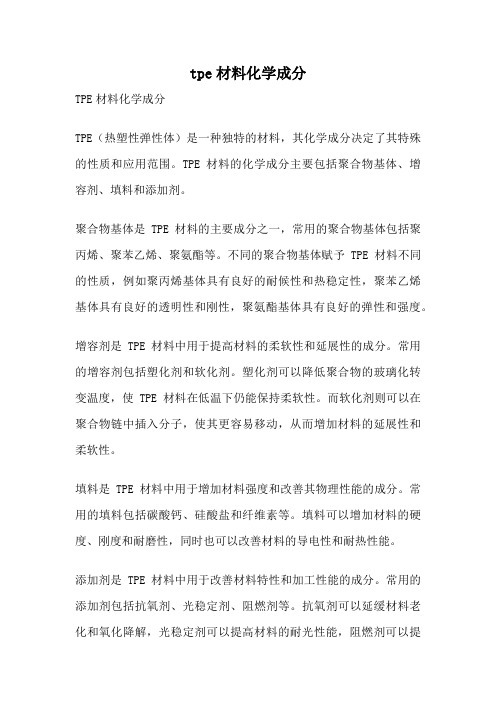
tpe材料化学成分TPE材料化学成分TPE(热塑性弹性体)是一种独特的材料,其化学成分决定了其特殊的性质和应用范围。
TPE材料的化学成分主要包括聚合物基体、增容剂、填料和添加剂。
聚合物基体是TPE材料的主要成分之一,常用的聚合物基体包括聚丙烯、聚苯乙烯、聚氨酯等。
不同的聚合物基体赋予TPE材料不同的性质,例如聚丙烯基体具有良好的耐候性和热稳定性,聚苯乙烯基体具有良好的透明性和刚性,聚氨酯基体具有良好的弹性和强度。
增容剂是TPE材料中用于提高材料的柔软性和延展性的成分。
常用的增容剂包括塑化剂和软化剂。
塑化剂可以降低聚合物的玻璃化转变温度,使TPE材料在低温下仍能保持柔软性。
而软化剂则可以在聚合物链中插入分子,使其更容易移动,从而增加材料的延展性和柔软性。
填料是TPE材料中用于增加材料强度和改善其物理性能的成分。
常用的填料包括碳酸钙、硅酸盐和纤维素等。
填料可以增加材料的硬度、刚度和耐磨性,同时也可以改善材料的导电性和耐热性能。
添加剂是TPE材料中用于改善材料特性和加工性能的成分。
常用的添加剂包括抗氧剂、光稳定剂、阻燃剂等。
抗氧剂可以延缓材料老化和氧化降解,光稳定剂可以提高材料的耐光性能,阻燃剂可以提高材料的阻燃性能。
TPE材料的化学成分决定了其在各个领域的广泛应用。
由于其独特的性质,TPE材料被广泛用于汽车、电子、医疗器械等领域。
在汽车领域,TPE材料可以用于制造密封件、管道、软管等零部件,其优异的耐热性和耐候性使其能够在恶劣的环境下保持稳定性能。
在电子领域,TPE材料可以用于制造电线电缆、插头等配件,其良好的绝缘性能和柔软性使其能够适应不同的电子设备需求。
在医疗器械领域,TPE材料可以用于制造医用管道、手柄、密封件等产品,其良好的生物相容性和耐化学性能使其成为理想的医疗材料。
TPE材料的化学成分决定了其特殊的性质和广泛的应用范围。
聚合物基体、增容剂、填料和添加剂共同作用,使TPE材料具有优异的弹性、柔软性、耐候性和耐热性等特性,使其成为众多领域中的理想选择。
橡胶的化学成分
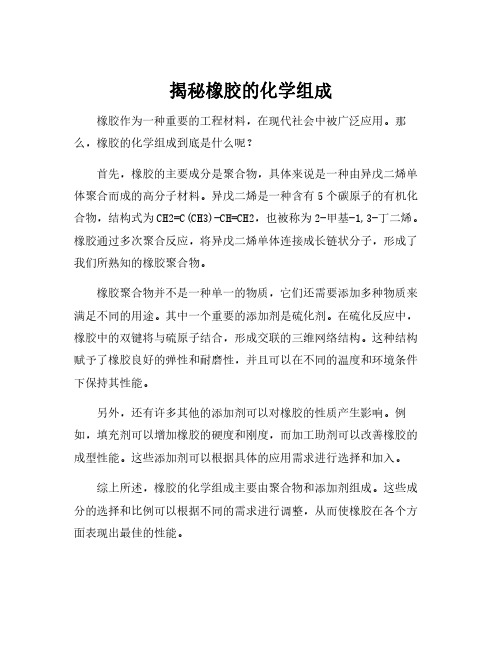
揭秘橡胶的化学组成
橡胶作为一种重要的工程材料,在现代社会中被广泛应用。
那么,橡胶的化学组成到底是什么呢?
首先,橡胶的主要成分是聚合物,具体来说是一种由异戊二烯单体聚合而成的高分子材料。
异戊二烯是一种含有5个碳原子的有机化合物,结构式为CH2=C(CH3)-CH=CH2,也被称为2-甲基-1,3-丁二烯。
橡胶通过多次聚合反应,将异戊二烯单体连接成长链状分子,形成了我们所熟知的橡胶聚合物。
橡胶聚合物并不是一种单一的物质,它们还需要添加多种物质来满足不同的用途。
其中一个重要的添加剂是硫化剂。
在硫化反应中,橡胶中的双键将与硫原子结合,形成交联的三维网络结构。
这种结构赋予了橡胶良好的弹性和耐磨性,并且可以在不同的温度和环境条件下保持其性能。
另外,还有许多其他的添加剂可以对橡胶的性质产生影响。
例如,填充剂可以增加橡胶的硬度和刚度,而加工助剂可以改善橡胶的成型性能。
这些添加剂可以根据具体的应用需求进行选择和加入。
综上所述,橡胶的化学组成主要由聚合物和添加剂组成。
这些成分的选择和比例可以根据不同的需求进行调整,从而使橡胶在各个方面表现出最佳的性能。
euv光刻胶成分
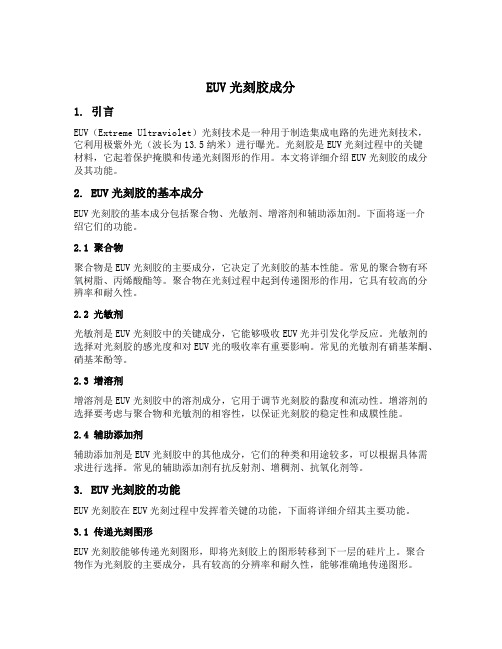
EUV光刻胶成分1. 引言EUV(Extreme Ultraviolet)光刻技术是一种用于制造集成电路的先进光刻技术,它利用极紫外光(波长为13.5纳米)进行曝光。
光刻胶是EUV光刻过程中的关键材料,它起着保护掩膜和传递光刻图形的作用。
本文将详细介绍EUV光刻胶的成分及其功能。
2. EUV光刻胶的基本成分EUV光刻胶的基本成分包括聚合物、光敏剂、增溶剂和辅助添加剂。
下面将逐一介绍它们的功能。
2.1 聚合物聚合物是EUV光刻胶的主要成分,它决定了光刻胶的基本性能。
常见的聚合物有环氧树脂、丙烯酸酯等。
聚合物在光刻过程中起到传递图形的作用,它具有较高的分辨率和耐久性。
2.2 光敏剂光敏剂是EUV光刻胶中的关键成分,它能够吸收EUV光并引发化学反应。
光敏剂的选择对光刻胶的感光度和对EUV光的吸收率有重要影响。
常见的光敏剂有硝基苯酮、硝基苯酚等。
2.3 增溶剂增溶剂是EUV光刻胶中的溶剂成分,它用于调节光刻胶的黏度和流动性。
增溶剂的选择要考虑与聚合物和光敏剂的相容性,以保证光刻胶的稳定性和成膜性能。
2.4 辅助添加剂辅助添加剂是EUV光刻胶中的其他成分,它们的种类和用途较多,可以根据具体需求进行选择。
常见的辅助添加剂有抗反射剂、增稠剂、抗氧化剂等。
3. EUV光刻胶的功能EUV光刻胶在EUV光刻过程中发挥着关键的功能,下面将详细介绍其主要功能。
3.1 传递光刻图形EUV光刻胶能够传递光刻图形,即将光刻胶上的图形转移到下一层的硅片上。
聚合物作为光刻胶的主要成分,具有较高的分辨率和耐久性,能够准确地传递图形。
3.2 保护掩膜在EUV光刻过程中,光刻胶起到保护掩膜的作用。
掩膜是用于遮挡光刻胶的部分区域,使得只有特定区域的光刻胶暴露在EUV光下。
光刻胶能够保护掩膜免受损害,并在光刻过程中保持其完整性。
3.3 调节感光度光敏剂是EUV光刻胶中的关键成分,它能够吸收EUV光并引发化学反应。
光敏剂的种类和浓度可以调节光刻胶的感光度,从而控制光刻胶的曝光量和图形的尺寸。
八字胶成分
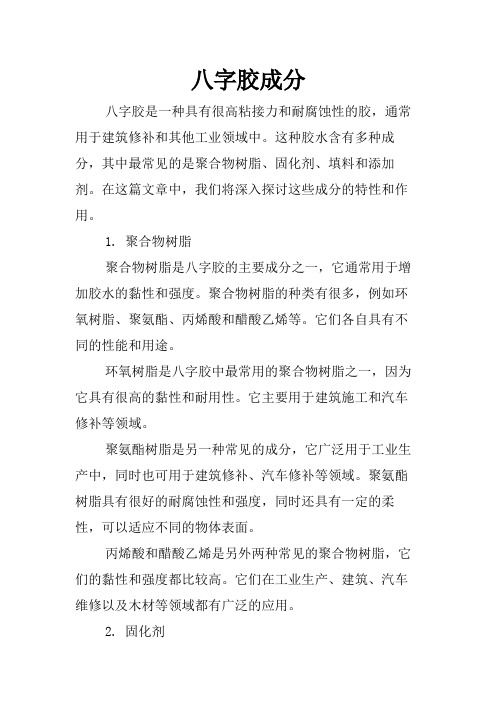
八字胶成分八字胶是一种具有很高粘接力和耐腐蚀性的胶,通常用于建筑修补和其他工业领域中。
这种胶水含有多种成分,其中最常见的是聚合物树脂、固化剂、填料和添加剂。
在这篇文章中,我们将深入探讨这些成分的特性和作用。
1. 聚合物树脂聚合物树脂是八字胶的主要成分之一,它通常用于增加胶水的黏性和强度。
聚合物树脂的种类有很多,例如环氧树脂、聚氨酯、丙烯酸和醋酸乙烯等。
它们各自具有不同的性能和用途。
环氧树脂是八字胶中最常用的聚合物树脂之一,因为它具有很高的黏性和耐用性。
它主要用于建筑施工和汽车修补等领域。
聚氨酯树脂是另一种常见的成分,它广泛用于工业生产中,同时也可用于建筑修补、汽车修补等领域。
聚氨酯树脂具有很好的耐腐蚀性和强度,同时还具有一定的柔性,可以适应不同的物体表面。
丙烯酸和醋酸乙烯是另外两种常见的聚合物树脂,它们的黏性和强度都比较高。
它们在工业生产、建筑、汽车维修以及木材等领域都有广泛的应用。
2. 固化剂固化剂是八字胶中的另一个重要成分,在使用前需要和树脂混合,以加速反应并增强胶水的粘接力和强度。
固化剂的种类也很多,例如胺类、酚醛类、异氰酸酯等。
胺类固化剂是八字胶中最常用的固化剂之一,它可以应用于很多领域,例如汽车维修、建筑修补、金属加工等。
胺类固化剂可能会因为温度和湿度的变化而造成纵向收缩,因而需要注意施工条件。
酚醛类固化剂的耐腐蚀性和抗高温性都比较高,常常用于制造耐用的机械和电器零部件。
异氰酸酯固化剂则主要用于制造聚氨酯和其他弹性材料。
3. 填料填料是八字胶中的另一个重要成分,它通常用于填补空隙和增强胶水的力学性能。
填料的种类有很多,例如硅酸盐、树脂微珠、钙碳酸盐等。
硅酸盐的密度比较低,不仅可以减轻胶水的重量,而且可以增强其强度和硬度。
树脂微珠则可以提供较好的隔热性能和吸音性能,常常用于制造隔热材料和声音减震材料等。
钙碳酸盐则可以增加胶水的粘度和硬度,适用于建筑修补等领域。
4. 添加剂添加剂是一些可以为胶水提供特殊性能的物质,例如增塑剂、稳定剂、抗氧化剂等。
胶水的分子式
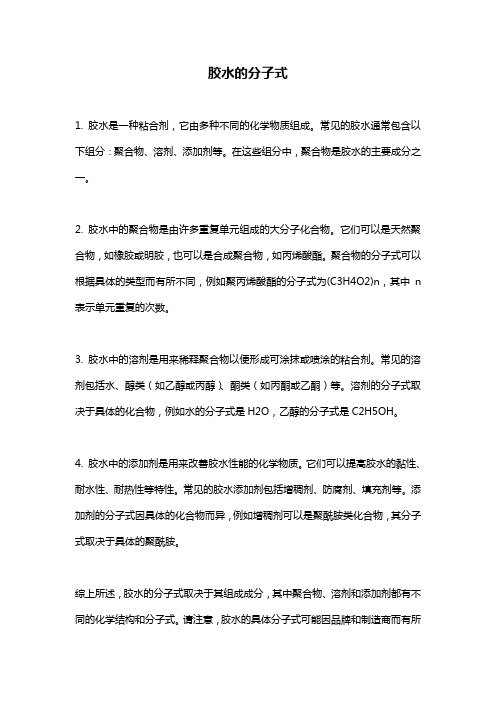
胶水的分子式
1. 胶水是一种粘合剂,它由多种不同的化学物质组成。
常见的胶水通常包含以下组分:聚合物、溶剂、添加剂等。
在这些组分中,聚合物是胶水的主要成分之一。
2. 胶水中的聚合物是由许多重复单元组成的大分子化合物。
它们可以是天然聚合物,如橡胶或明胶,也可以是合成聚合物,如丙烯酸酯。
聚合物的分子式可以根据具体的类型而有所不同,例如聚丙烯酸酯的分子式为(C3H4O2)n,其中n 表示单元重复的次数。
3. 胶水中的溶剂是用来稀释聚合物以便形成可涂抹或喷涂的粘合剂。
常见的溶剂包括水、醇类(如乙醇或丙醇)、酮类(如丙酮或乙酮)等。
溶剂的分子式取决于具体的化合物,例如水的分子式是H2O,乙醇的分子式是C2H5OH。
4. 胶水中的添加剂是用来改善胶水性能的化学物质。
它们可以提高胶水的黏性、耐水性、耐热性等特性。
常见的胶水添加剂包括增稠剂、防腐剂、填充剂等。
添加剂的分子式因具体的化合物而异,例如增稠剂可以是聚酰胺类化合物,其分子式取决于具体的聚酰胺。
综上所述,胶水的分子式取决于其组成成分,其中聚合物、溶剂和添加剂都有不同的化学结构和分子式。
请注意,胶水的具体分子式可能因品牌和制造商而有所
不同,所以在使用时需要查看产品标签或生产商提供的信息。
- 1、下载文档前请自行甄别文档内容的完整性,平台不提供额外的编辑、内容补充、找答案等附加服务。
- 2、"仅部分预览"的文档,不可在线预览部分如存在完整性等问题,可反馈申请退款(可完整预览的文档不适用该条件!)。
- 3、如文档侵犯您的权益,请联系客服反馈,我们会尽快为您处理(人工客服工作时间:9:00-18:30)。
8. POLYMERS ANDTHEIR ADDITIVESThe term macromolecule, or polymer, isapplied to substances of high molecularweight that are composed of a large number (usually at least 100) of units of low molecular weight joined by covalent bonds. If the low molecular weight units making up the macromolecule are bonded end-to-end in a long chain and no covalent chemical bonds exist between the chains, the macromolecules are called linear polymers. Such polymers, unless of extremely high molecular weight (1,000,000), can usually be dissolved and, when heated, they soften or melt so that they can be extruded into fibers or moulded into desired shapes. These polymers are said to be thermoplastic. On the other hand, if the polymer chains are linked together at numerous points, the polymer is one large three-dimensional molecule, infusible and insoluble. Such polymers are called cross-links. Certain linear polymers, referred to as thermosetting, contain groups which, when heated, react to give cross-linked polymers.1The process by which small molecules undergo multiple combination to form macromolecules is polymerization. Small molecules from which amacromolecule or polymer can be made are calledmonomers. Two types of polymerization arerecognized: (1)condensation polymerization and (2) addition polymerization.A polymer-forming reaction involving elimination of a small molecule such as water or alcohol between monomer units is described as condensation polymerization.2 In addition polymerization, unsaturated or cyclic molecules add to each other without elimination of any portion of the monomer molecule. The empirical formula of the polymer is then, of course, the same as that of the monomer.Reactions capable of forming macromolecules by either addition or condensation polymerization must be functionally capable of proceeding indefinitely. Whenever two monomer molecules react, the product must contain a functional group capable of reacting with another molecule of monomer. In condensation polymerization, each monomer unit must have at least two functional groups. In addition polymerization, the monomer need have only one functional group - the presence of two or more functional groups usually leads to the production of cross-linked addition polymers.The modulus and other physical properties of polymer can be improved by the addition of fillers and other additives, such as plasticizers, antioxidants, heat stabilizers, ultraviolet stabilizers, and flame retardants. Additives are essential functional ingredients of polymers, and whenever possible, each should be used in optimum amounts for the attainment of high-quality products.Plasticizer: According to the ASTM-D-883 definition, a plasticizer is a material incorporated in a plastic to increase its workability and flexibility or distensibility. The addition of a plasticizer may lower the melt viscosity, elastic modulus, and glass transition temperature (Tg) of a plastic.Antioxidants: Polymers such as polypropylene (PP) are not usable outdoors without appropriate stabilizers, because of the presence of readily removable hydrogen atoms on the tertiary carbon atoms. PP and many other polymers (RH) are attacked during processing or outdoor use in the absence of stabilizers because of a chain degradation reaction. The rate ofchain-reaction degradation is retarded by the presence of smallamounts of antioxidants.Heat Stabilizers: In addition to the free-radical chaindegradation described for polyolefins, another type of degradation (dehydrohalogenation) also occurs with chlorine-containing polymers such as PVC. When heated, PVC may lose hydrogen chloride and form a chromophoric conjugated polyene structure. This type of degradation can be decreased by the presence of lead, barium and cadmium salts which act as scavengers for hydrogen chloride and therefore can be used as heat stabilizers.Ultraviolet Stabilizers: While much of the sun’s high-energy radiation is absorbed by the atmosphere, some radiation in the 280 to 400 nm(ultraviolet) range reaches the earth’s surface. Since the energy of this radiation is 100 to 72 kcal, it is sufficiently strong to cleave covalent bonds and cause yellowing and embrittlement of organic polymers. Since the effect of ultraviolet radiation on synthetic polymers is similar to its effect on the human skin, it is not surprising that ultraviolet stabilizers such as phenyl salicylate have been used for many years in suntanning lotions.Flame Retardants: Since some polymers are used as shelter and clothing and in household furnishing, it is essential that they have good flame resistance. Combustion is a chain reaction that may be initiated and propagated by free radicals like the hydroxyl free radical. Hydroxyl radicals may be produced by the reaction of oxygen with macroalkyl radicals. Halogen radicals produced by the reaction of hydroxyl radicals with halides, such as HX, may serve as terminators for the chain reaction.Other polymer additives are colorants, antistatic agents, foaming agents, preservatives, and processing aid or lubricants.译文:8聚合物及其添加剂大分子或聚合物这个名称,被用来表示一些高分子量的物质。
